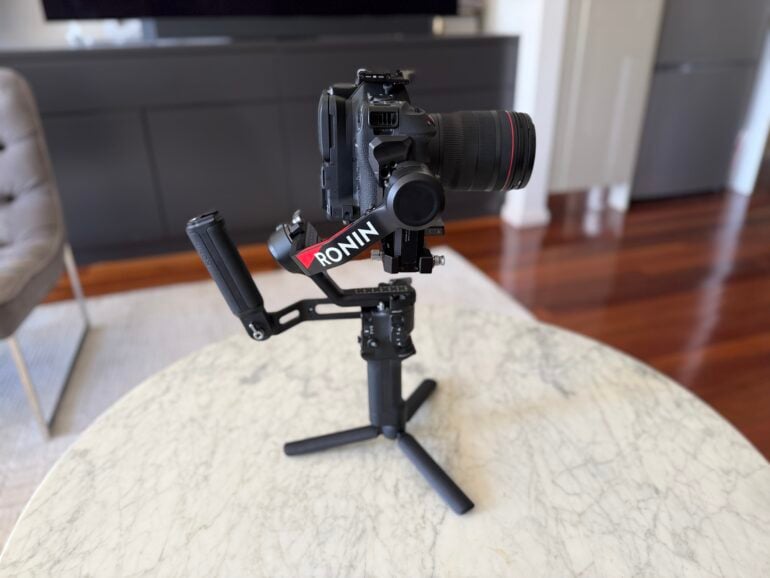
Over a few short years, DJI has become a major player in the video production space. It wouldn’t be a stretch to say that it practically owns the handheld stabiliser, or gimbal, market, and it’s developed an industry-respected ecosystem of pro video tools, accessories and even cameras.
With its Ronin line of handheld stabilisers now in their fourth generation, I wanted to see how the DJI RS4 would complement our video production needs.
For context, here at GadgetGuy we have a YouTube channel with over 200K subscribers, so we create weekly long-form and social videos for both our audience and partners. With our A and B cameras, which are Canon EOS C70 and C80s, we typically use a tripod. However, for more dynamic, moving footage we’ve relied on a DJI Pocket 3, which is a lightweight camera with an integrated gimbal. Thanks to the RS4, we wanted to start using our main cameras for dynamic footage as well.
What can the DJI RS4 do?
Apart from being a 3-axis gimbal, some of the standout features of the RS4 include:
- 3 kg payload capacity
- Fourth-generation RS stabilisation algorithm for smoother footage
- Second-generation automated axis locks for faster setup
- Native vertical shooting without extra accessories
- Bluetooth shutter and zoom control for compatible cameras
- 1.8-inch OLED touchscreen with auto-lock
- 12-hour runtime and 18W PD fast-charging battery grip
- Compatible with DJI RS accessories and the Ronin app
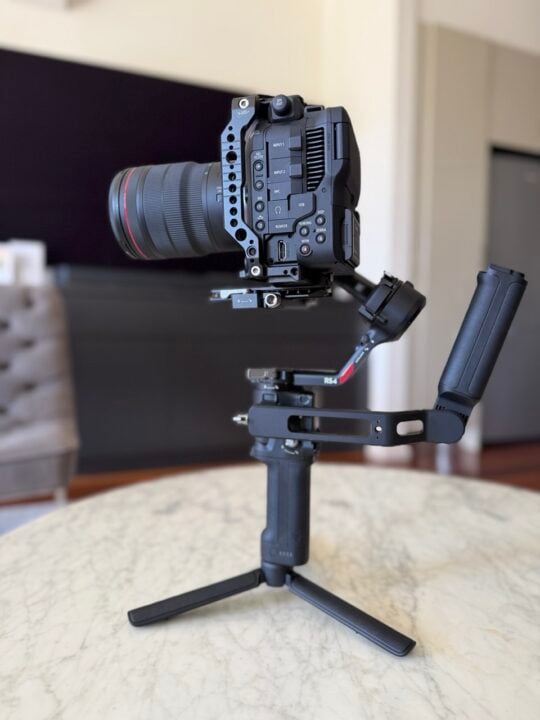
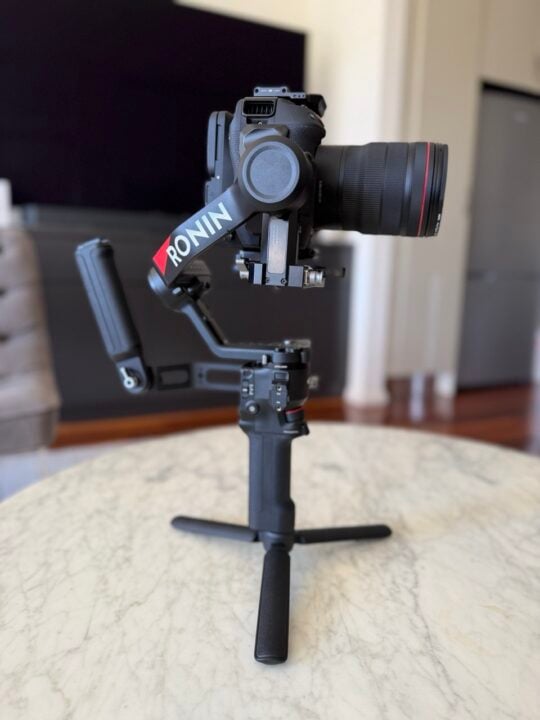
Balancing and setup
From the start, we knew we’d be pushing the DJI RS4 close to its limits with the weight of the Canon C80 plus a lens. All up, and with some rigging, the system weighed about 2.7 kilograms, which is close to the RS4’s 3kg limit. The Canon C80’s tall and wide body also meant limited clearance around the three axis arms.
For most people, you’d likely use a smaller camera such as the Sony FX3, which is ideal for the DJI RS4. Canon’s C80 currently has limited compatibility, meaning control cables for functions like focus or record start/stop via the integrated buttons don’t work. Hopefully, the C80 will be added to the compatibility list soon.
Despite this, setting up the camera on the DJI RS4 was surprisingly easy. The base plate attaches quickly, and a handy guide helps you position it correctly.
The second-generation automated axis locks are a real timesaver. They let you lock or unlock each axis while adjusting balance, and once you power down or enter sleep mode, the system automatically locks. With a heavy camera like the C80, this prevents it from swinging into an arm.
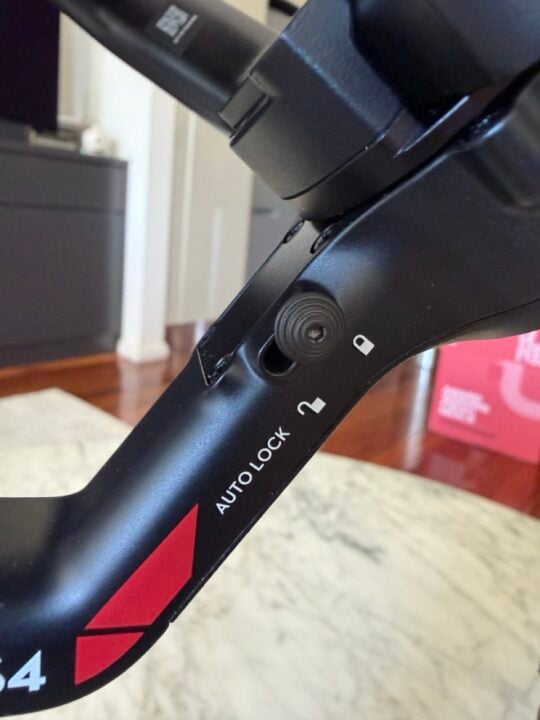
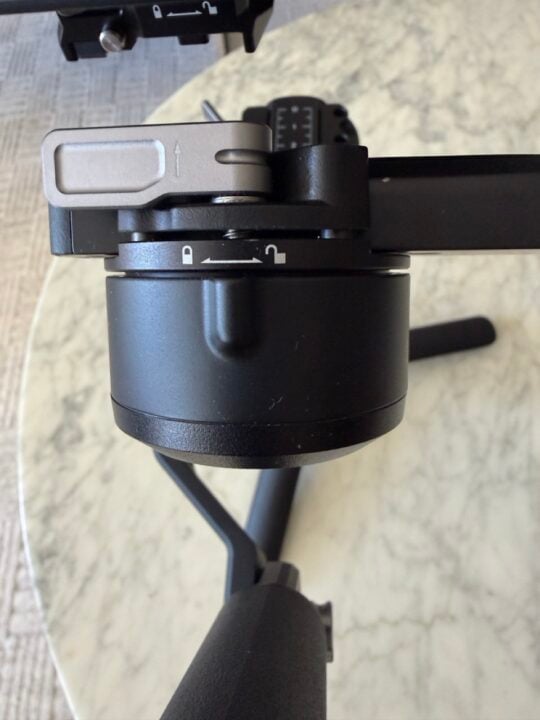
The Teflon-coated arms make balancing smoother, though the pan arm was a little tight. A fine-tuning dial on the tilt base allows precise adjustments, and this is especially useful when swapping lenses or using a zoom. You can easily rebalance with a quick turn of the dial.
The tilt arm has also been extended by 8.5mm from the DJI RS3 to accommodate longer camera and lens combinations.
Specifications: DJI Ronin RS4
| Specification | Detail |
|---|---|
| Payload | Up to 3 kg (6.6 lb) |
| Gimbal weight (body) | Approx. 1,066 g |
| Grip weight | Approx. 203 g |
| Battery / runtime | ~ 2.5 h charge (18 W PD) / ~ 12 h runtime |
| Max rotation speed | Pan / Tilt / Roll = 360°/s |
| Mechanical range | Pan: 360° continuous Tilt: –112° to +214° Roll: –95° to +240° |
| Dimensions (folded) | 245 × 255 × 75 mm (excl. camera & grip) |
| Dimensions (unfolded) | 370 × 191 × 189 mm (with grip) |
| Gimbal modes | Pan Follow, Pan & Tilt Follow, FPV (customisable), 3D Roll 360, Portrait |
| Creative / software modes | Panorama, Timelapse / Motionlapse, Track, Force Mobile, ActiveTrack, Virtual Joystick |
| Connectivity & ports | Bluetooth 5.1, USB-C, RSA port, NATO rails, Cold shoe |
| Accessory compatibility | DJI RS series accessories (focus motor, image transmitter, handles) DJI Ronin Image Transmitter (HD video + remote control) DJI Focus Pro Motor (sold separately) Battery grips: BG21 (standard), BG70 (high-capacity) |
| Operating temperature | –20 °C to 45 °C |
| Price (RRP) | AU $799 |
| Shop | DJI Store |
| Warranty | 12 months manufacturer warranty (consumer use) |
Mounts and vertical shooting
The supplied mounting plate should work with most cameras, offering both 1/4-inch and 3/8-inch screws, and the RS4 comes with a sturdy tripod mount that screws into the battery handle.
One standout feature is the ability to switch from landscape to vertical shooting via a quick release. The base plate can be remounted vertically using the same stub, secured by a locking screw and button.
Unfortunately, the Canon C80 is too large to use comfortably in vertical orientation without hitting one of the axis arms, but it’s still possible. Smaller cameras should fit perfectly well and make this feature invaluable, especially with vertical content now so essential.
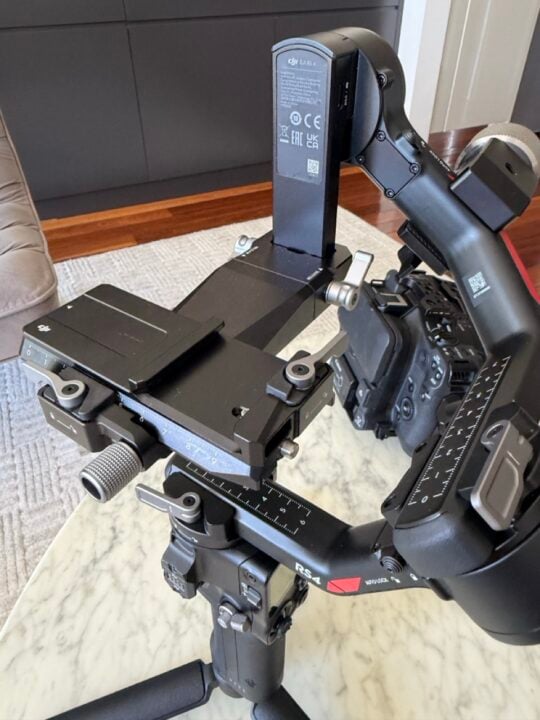
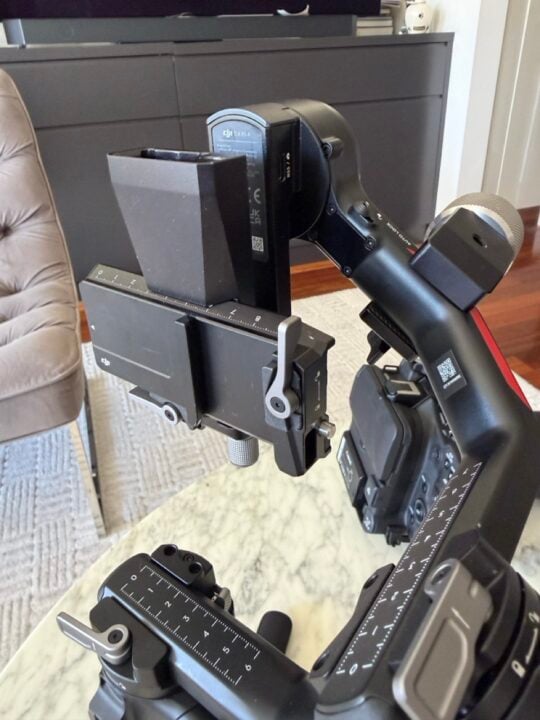
Controls and touchscreen
The RS4’s control system is refreshingly straightforward, which is exactly what you want when focusing on your shot. There’s a 1.8-inch OLED touchscreen for viewing gimbal modes and adjusting settings.
The main controls include a focus wheel, trigger, and joystick. Sliding switches on either side of the screen allow quick, tactile adjustments, such as toggling the joystick between zoom or tilt, or selecting one of the three gimbal modes.
The modes include Pan Follow (PF), Pan Tilt Follow (PTF) and FPV (First Person View), plus a customisable 3D Roll 360 mode. The trigger can also be assigned to engage FPV mode.
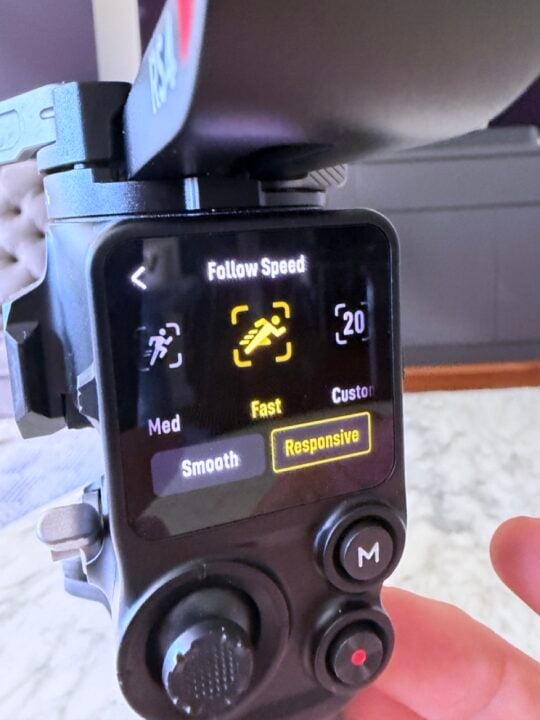
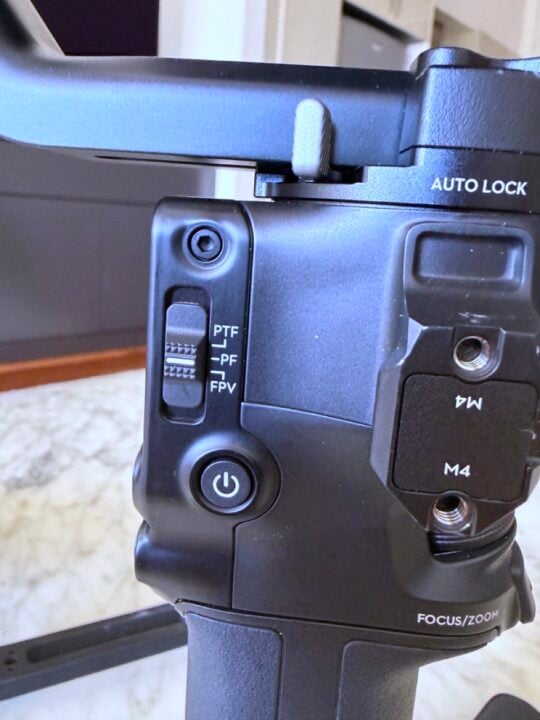
The joystick makes it easy to pan or tilt smoothly while the gimbal rests on its tripod. Through the Ronin app, you can access preset features like Motionlapse, Track and Panorama, and these are great for stylised shots, though I didn’t use them.
The screen also has an auto-lock feature to prevent accidental touches and dims to reduce power use.
Shooting experience
Even with my setup weighing over 2.7 kg, the RS4’s motors delivered plenty of torque and stability. The three-axis system provides full 360° movement, and I mainly used Pan Tilt Follow and FPV modes. These worked beautifully for starting wide on a subject, pushing in, tilting towards an object in their hand, then pulling back, all with fluid motion.
It was also excellent for walk-and-talk shots where I moved backwards with the subject. Even rounding corners, the footage stayed smooth and natural. Dramatic tilt-down moves also felt well controlled, with no unwanted drift from the camera’s weight.
Using the included extended handle provided extra leverage for low-angle shots and prevented arm fatigue, and I would have suffered without this.
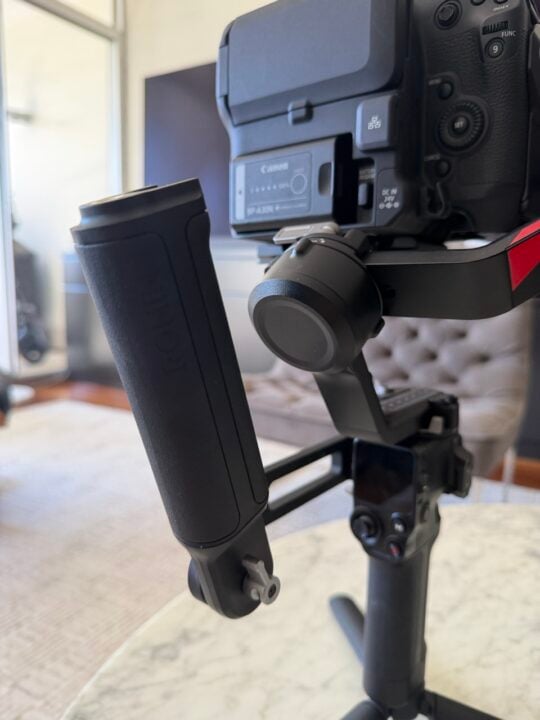
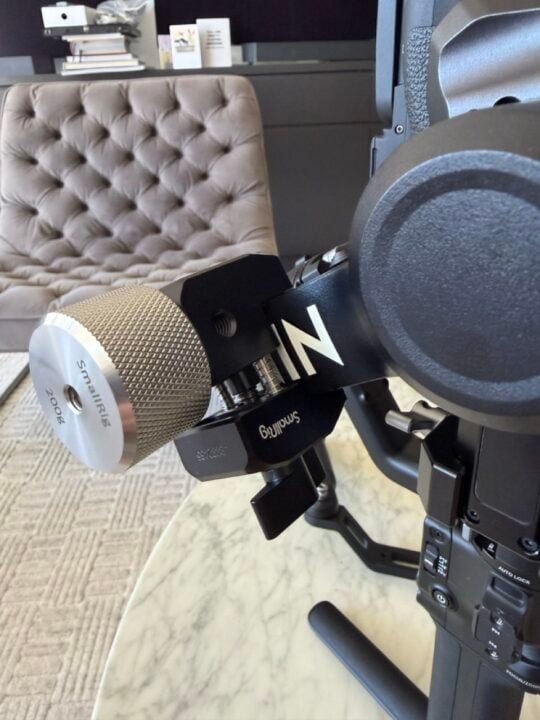
The fourth-generation stabilisation algorithm is designed to handle shaking from running or vehicle movement. I didn’t notice any issues, it just worked quietly in the background to deliver smooth results.
While I had to use a counterweight to balance my C80, the RS4 handled it well. However, for perfect balance without added weights, the RS4 Pro would be the better choice thanks to its longer arms and higher 4.5 kg payload.
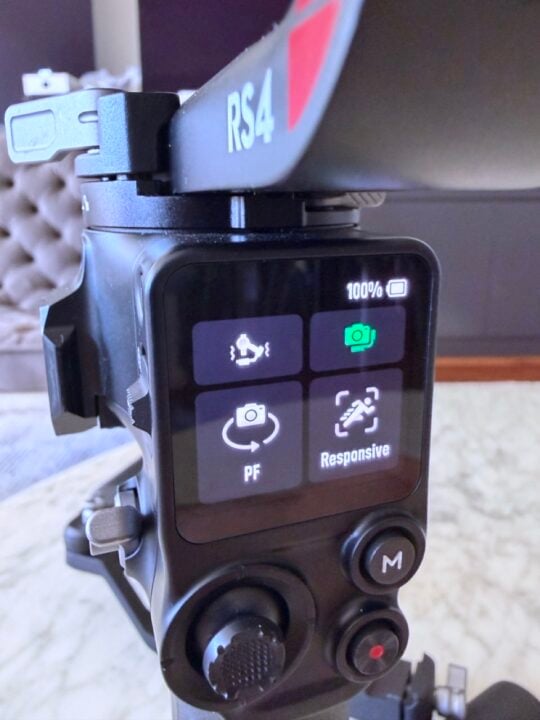
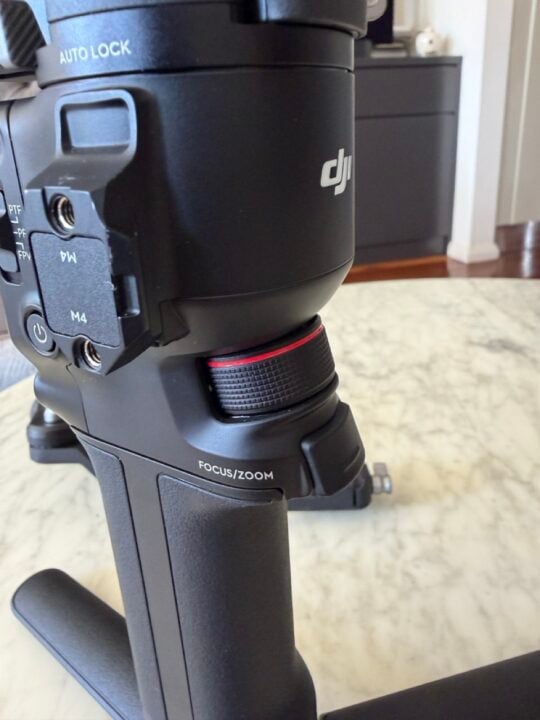
Battery performance
Battery life was quite good. The 3,000 mAh battery is integrated into the handle and rated for up to 12 hours, or around 3.5 hours of continuous operation, according to DJI. It charges in about 2.5 hours via USB-C.
Given my heavier setup, I averaged around three hours before the battery ran low. For longer shoots, DJI offers the RS BG70 High Capacity Battery Grip, which extends runtime to nearly 30 hours.
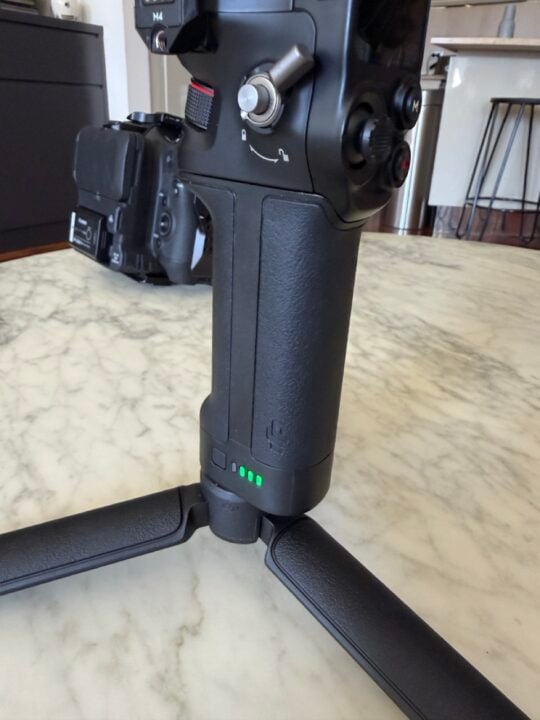
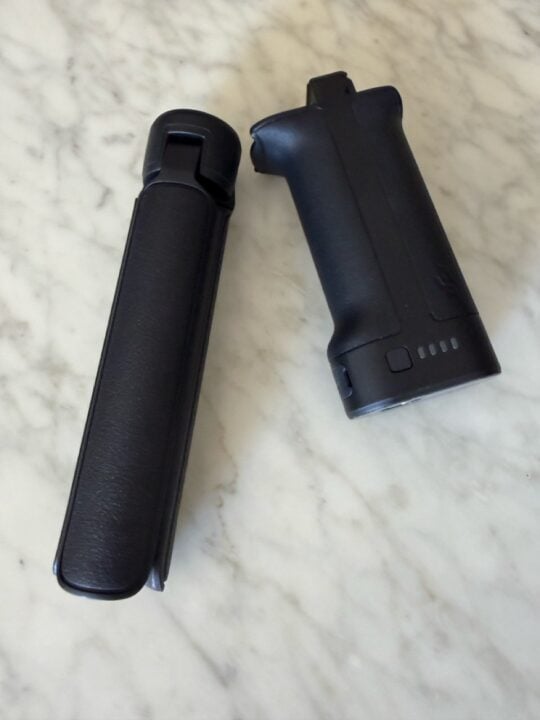
Pro connectivity and ports
The RS4 can leverage DJI’s growing professional ecosystem, offering a wide range of add-ons and connectivity options. It includes Bluetooth and USB-C for linking to your camera, providing features like shutter and zoom control.
You can also pair it with the DJI Focus Pro Motor and LiDAR system, controllable via the focus wheel or joystick. The extended handle includes an RSA communication port for adding accessories, and there’s a mount under the pan arm for attaching the DJI Ronin Image Transmitter.
Accessory ports
- Ronin Series Accessories (RSA) / NATO port
- 1/4″-20 mounting hole
- Cold shoe
- Video transmission port (USB-C)
- RSS camera control port (USB-C)
- Focus motor port (USB-C)
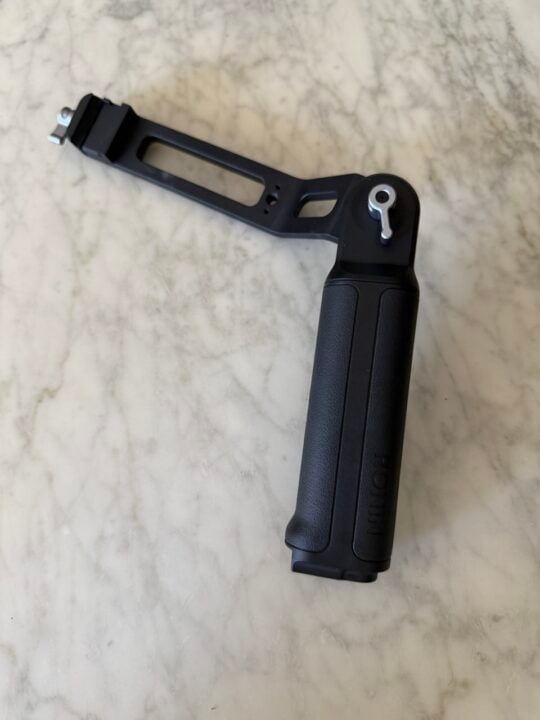
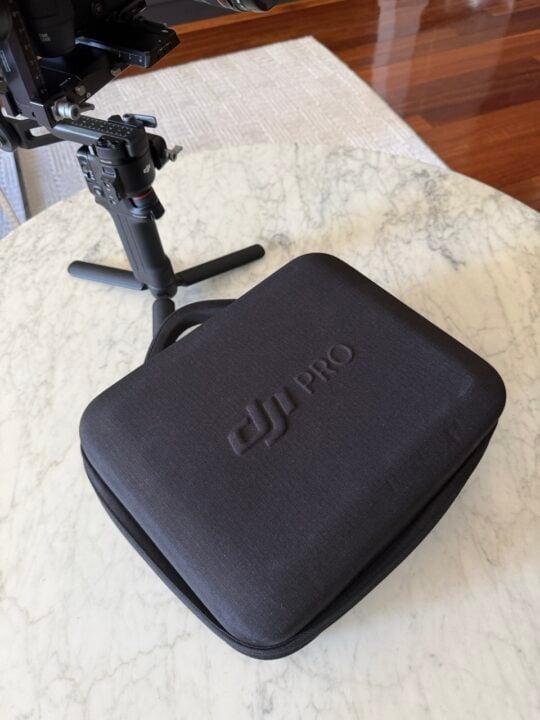
DJI RS4 vs RS4 Pro
While the RS4 is feature-rich and connects seamlessly with DJI’s pro ecosystem, the RS4 Pro is aimed at professional crews and larger setups. Here’s what it adds:
- Supports up to 4.5 kg with extended arm length
- Second-generation LiDAR focusing system
- Additional RSA port
- Faster 1.5-hour charging
- DJI Transmission support
- Carbon fibre arms (vs aluminium alloy)
- More mounting options – vehicle mount, Steadicam, etc.
- Costs AU$1,299 vs $799
Should you buy the DJI RS4?
I was impressed with the RS4’s evolution from the original Ronin gimbal I used years ago. It’s smoother, more powerful and far easier to balance, with quick transitions between portrait and landscape modes. Its capabilities expand further with DJI’s professional accessory range.
I am disappointed that DJI doesn’t yet support the Canon C80 (and temporarily dropped C70 support), but both can still be used manually.
For my use, the RS4 works well enough, though the RS4 Pro makes more sense for heavier cameras like the C80. That said, at AU$1,299 for the Pro versus AU$799 for the RS4, it’s a steep price jump if you don’t need the extra headroom.
For anyone using lighter setups, the RS4 is a kit bag essential — a fully featured, reliable, and refined stabiliser system for content creators and videographers alike.
The post DJI RS4 review – smooth moves for serious creators appeared first on GadgetGuy.



0 (mga) komento:
Mag-post ng isang Komento